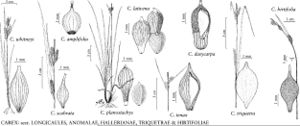Difference between revisions of "Carex dasycarpa"
Descr. Gram., 236. 1817.
FNA>Volume Importer |
FNA>Volume Importer |
||
| Line 23: | Line 23: | ||
|elevation=0–100 m | |elevation=0–100 m | ||
|distribution=Ala.;Fla.;Ga.;Miss.;S.C. | |distribution=Ala.;Fla.;Ga.;Miss.;S.C. | ||
| − | |discussion=<p>Carex dasycarpa is rare throughout most of its range.</p> | + | |discussion=<p><i>Carex dasycarpa</i> is rare throughout most of its range.</p> |
|tables= | |tables= | ||
|references= | |references= | ||
| Line 47: | Line 47: | ||
|publication year=1817 | |publication year=1817 | ||
|special status= | |special status= | ||
| − | |source xml=https://jpend@bitbucket.org/aafc-mbb/fna-data-curation.git/src/ | + | |source xml=https://jpend@bitbucket.org/aafc-mbb/fna-data-curation.git/src/8f726806613d60c220dc4493de13607dd3150896/coarse_grained_fna_xml/V23/V23_907.xml |
|genus=Carex | |genus=Carex | ||
|section=Carex sect. Hallerianae | |section=Carex sect. Hallerianae | ||
Revision as of 17:11, 18 September 2019
Plants loosely cespitose; rhizomes slender. Culms 13–40 cm, smooth, sparsely pilose. Leaf blades M-shaped in cross section when young, 2–4.5 mm wide, at least proximal pilose. Inflorescences: proximal bracts sheathless or sheath not more than 2 mm; lateral spikes 6–27 × 4–9 mm, all in distal 1/2 of stem; terminal spike 8–20 × 1–2.5 mm. Pistillate scales 3-veined, ovate, 2.3–3 × 1.3–2.2 mm, shorter than perigynia, apex acute, sometimes with awn to 0.7 mm. Staminate scales 3-veined, 3.2–5 × 1.2–2 mm. Perigynia 20–30-veined, narrowly ovoid, 4.5–6 × 1.4–2 mm, spongy at base, subglabrous to puberulent proximally, pilose distally, at least some hairs 0.3–0.4 mm; beak obscure, 0.3–0.5 mm. Achenes: stipe to 1 mm; bodies 2.5 × 1.3–1.7 mm, filling only distal part of perigynia.
Phenology: Fruiting early spring–summer.
Habitat: Hardwood forests on sand
Elevation: 0–100 m
Distribution

Ala., Fla., Ga., Miss., S.C.
Discussion
Carex dasycarpa is rare throughout most of its range.
Selected References
None.
